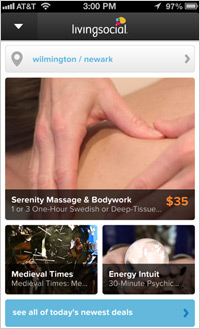Commentary
What A Deal: Group Buying At The Forefront Of Mobile Commerce
- by Steve Smith , Staff Writer @popeyesm, March 27, 2013
 Anyone remember when the group-buying
phenomenon was going to be the new form of local marketing to undermine all other forms? When Groupon and LivingSocial emerged on the scene, enthusiasm for the format was palpable. There was good
reason for the enthusiasm. I myself am pretty resistant to special offers of any kind, and yet I still have a nice little lineup of discounts in my LivingSocial account ready to be redeemed.
Anyone remember when the group-buying
phenomenon was going to be the new form of local marketing to undermine all other forms? When Groupon and LivingSocial emerged on the scene, enthusiasm for the format was palpable. There was good
reason for the enthusiasm. I myself am pretty resistant to special offers of any kind, and yet I still have a nice little lineup of discounts in my LivingSocial account ready to be redeemed.
But as many skeptics at the time predicted, discounting only goes so far -- especially on the local level. One local merchant nearby tried one of the group-buying services. The owner decided not to do it again because in the end it only netted increased sales at a radical discount to people who already knew about the store. She complained that it really wasn't working as a customer acquisition device.
Granted, when I talk to some of these buying services they argue that there are smart ways to use them for customer acquisition, and there are tactics and strategies to be deployed. And certainly in my research I have spoken to more than one or two businesses that literally were made by these local models.
The degree to which group buying has a permanent place in marketing of the future is still an open question, although I think it remains a pretty compelling model for the right offer and the right audience.
On mobile, companies like Groupon and LivingSocial became some of the earliest and most aggressive users of display advertising to drive people to specific localized offers. And whatever that segment’s troubles overall, it is doing for mobile commerce what initially it did for display advertising.
According to the company AffiliateWindow, which works with the affiliated e-commerce model across many sites, the combination of localization in the group-buy model and its heavy reliance on email is making it a key driver for mobile commerce. The company finds that on average, 14% of transactions across its network now are occurring on mobile devices, with little more than half of that happening on tablets. But the group-buying segment is about double that rate at 25.5% of all transactions now being generated on mobile handsets.
There are many reasons for this, and they highlight the ways that companies can capture mobile commerce activity more readily. For instance, people who use these services must be registered members. Most people responding to a group offer likely already have an account that is tied to a credit card and allows the user to make a fairly simple purchase on the spot. Likewise, many people remember the offer when they are close to the retailer.
The best group-buying services are already figuring out ways to capitalize on mobility by getting the offers closer to people when they and their phones are near the relevant merchant. And just as most other recent studies about mobile commerce and even media consumption continue to show the Apple platform as the most powerful, this survey shows that 56.5% of handset sales are coming from the iPhone. Only 26.9% of sales are coming from Android.
So what we're seeing here is not especially surprising, but worth emphasizing. Certain segments for multiple reasons are especially well-optimized for mobile transactions, and these are the segments that need to ensure a truly seamless transaction experience on handsets. Not coincidentally, these are also the segments that will be able to track ROI on the display advertising spend most effectively. These are also the companies to watch when it comes to mobile commerce innovations in creating frictionless experiences. They have the most at stake.



